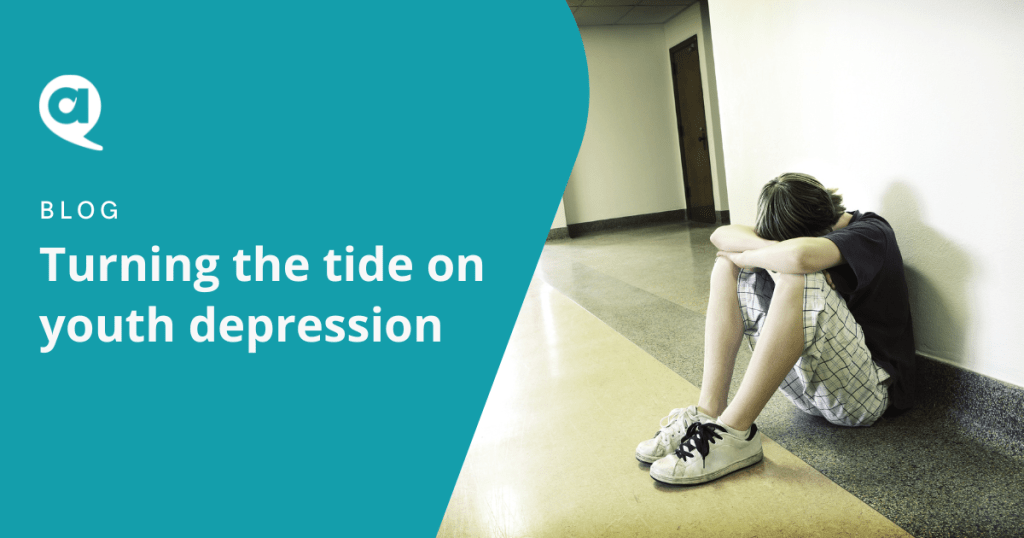
14 October 2022
By Janice Atkin,
Professional Learning Officer
ACHPER NSW
A new report examines depression in children and young people. We look at the discussion and what it means for PDHPE – how we can have a role in helping turn the tide.
Research shows that the prevalence of depression in young people has risen in the past decade. Additionally, there are worrying signs of a dramatic increase in depressive symptoms in children since the pandemic.
Turning The Tide On Depression: A vision that starts with Australia’s youth is a new report which focuses on depression in children, adolescents, and young adults.
Published by the Black Dog Institute it stimulates important discussion about preventing and managing mental health issues.
The report goes beyond just documenting the rising burden of mental health amongst young Australians. Researchers explore why these changes might be happening, and consider issues such as loneliness, financial strain, social inequality, digital media use, and sleep patterns.
Here we look at some of the report discussion relevant to PDHPE.
Young people and the digital world
Young people have increasing exposure to mature adult experiences in the digital world.
Smartphones have driven a significant change in how adolescents socialise and engage with their peers. The eSafety Commissioner reports:
- adolescents spend an average of 14.4 hours online each week
- approximately one-third of teenagers now spend an equal amount of time interacting with their peers online as they do in person
- online platforms offer adolescents a wide range of opportunities for social interaction, including chat groups, sharing and viewing video content, and social games.
There has also been a rise in adolescents’ exposure to inappropriate adult content through digital media. Almost two-thirds of adolescents report exposure to online content that depicts suicide, self-harm, drug taking, pornographic content, or violent material.
What this means for PDHPE:
PDHPE programs should mirror the lived experiences of students.
With technology and online interactions key to an adolescents’ daily life, they should be reflected in the programs we design. Specifically, learning in PDHPE should teach practical and realistic strategies for responding to:
- inappropriate online behaviour such as cyberbullying, trolling, grooming, catfishing, requesting nudes.
- inappropriate online content such as pornography, unwanted nudes, extremist views on race, gender or sexuality, and content dealing with self harm and drug taking.
Changing face of adolescence
Adolescence in the 2020’s can be categorised as a time of fewer opportunities for practising maturity and independence in day-to-day life.
Research suggests that adolescents are taking longer to reach adult milestones. For example, fewer adolescents are obtaining their driver’s license, working in paid roles, going out without their parents, having romantic relationships, and drinking alcohol (Twenge & Park, 2017).
What this means for PDHPE:
Given students may not be given opportunities in their day-to-day lives to develop important skills, PDHPE programs should teach:
- practical and realistic strategies for dealing with disappointment and failures
- knowledge and skills needed to manage their growing independence
- how to strengthen their self-identity and self-confidence
- adaptability and perseverance to deal effectively with an unpredictable and ever-changing world.
A greater amount of screen time is linked with depression in teens BUT ….
The factors often posited for why increased screen time is linked to increase risk of depression in young people include cyberbullying, negative self-concept, peer relationship breakdown or disturbed sleep.
However, the analysis in this latest report shows that none of these proposed factors, by themselves, fully explain the links between the higher levels of screen time and depression.
The report raises the possibility that the link between screen time and depression may be reversed – rather than screen time causing depression, depressed teens may turn to digital media as an accessible, although not always effective, way of coping.
What this means for PDHPE:
Digital technologies can have a powerful influence over our emotional state – both good and bad.
An emerging body of evidence suggests that adolescents may use digital technology as a means of regulating emotions. For adolescents who use digital media to play games or to actively engage with friends online, turning to digital technology as a means of regulating negative emotions may be an effective strategy.
Emotional regulation is a key aspect of the self-management skills domain and should be taught explicitly as part of our PDHPE programs. When planning lesson activities that focus on practising and refining emotional regulation skills ensure that digital tools are part of the strategies students explore.
Help-seeking is also a key skill to be developed through PDHPE. The internet has become the third most common place that adolescents experiencing psychological distress turn to for help, after friends and family.
Adolescents in marginalised groups use digital technologies to find and connect with supportive communities. Embedding digital technologies in the help-seeking strategies we teach through PDHPE is vital.
Tools and apps to help
For suggestions on evidence-based digital tools and apps for emotional regulation and help-seeking, check out the ReachOut.com website.
More information
The upcoming ACHPER NSW 2022 PDHPE Conference will include a range of helpful workshops in these topic areas.
Article sources:
Twenge, J. M., & Park, H. (2017). The decline in adult activities among U.S. adolescents, 1976-2016. Child Development


